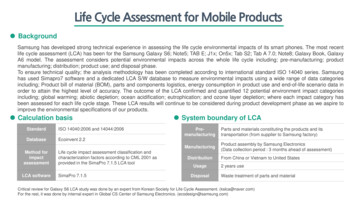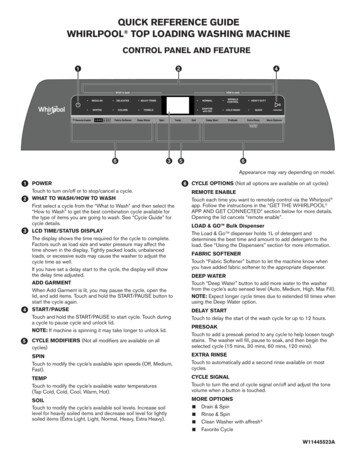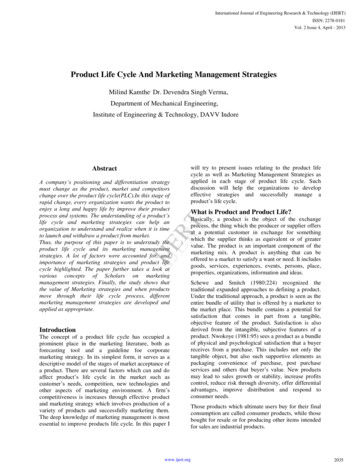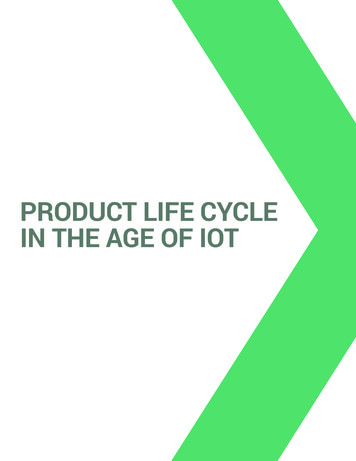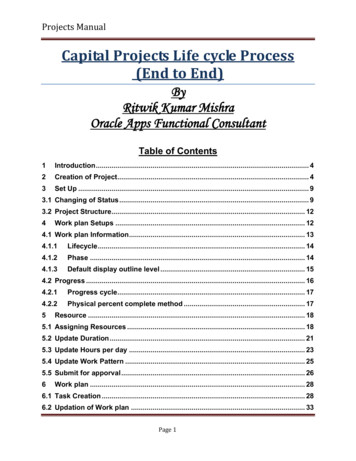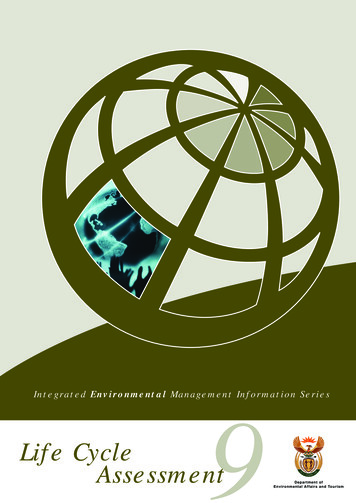
Transcription
Integrated Environmental Management Information Series9Life CycleAssessmentD epart ment ofE nvironm ent al Af f airs and Tourism
Li f e C y c l e Asse ssm e n tOther topics in the series of overview information documents on the concepts of, and approaches to, integrated environmentalmanagement are listed below. Further titles in this series are being prepared and will be made available periodically. Sequenceof release and titles are subject to 2:3:4:5:6:7:8:9:10:11:12:13:14:15:16:Overview of Integrated Environmental ManagementScreeningScopingStakeholder EngagementSpecialist StudiesImpact SignificanceEcological Risk AssessmentCumulative Effects AssessmentCost Benefit AnalysisLife Cycle AssessmentStrategic Environmental AssessmentCriteria for determining Alternatives in EIAEnvironmental Management PlansReview in Environmental Impact AssessmentEnvironmental AuditingEnvironmental Impact ReportingEnvironmental EconomicsISSUED BYDepartment of Environmental Affairs and TourismPrivate Bag X447Pretoria0001 South AfricaThis document is available on the DEAT web site: http://www.deat.gov.zaPLEASE NOTE: This document is intended as an information source and cannot take the place of legal advice in a specific situationgoverned by legislation. The document is not a guideline document, but serves as a reference and supportive text. This document willnot take the place of official guidelines and regulations published by DEAT.COPYRIGHT Department of Environmental Affairs and Tourism 2004. ALL RIGHTS RESERVEDThis document is copyright under the Berne Convention. Apart from the purpose of private study, research or teaching, in terms ofthe Copyright Act (Act No. 98 of 1978) no part of this document may be reproduced or transmitted in any form or by any means,electronic or mechanical, including photocopying, recording or by any information storage and retrieval system, without permissionin writing from DEAT. Likewise, it may not be lent, resold, hired out or otherwise disposed of by way of trade in any form of bindingor cover other than that in which it is published.ENQUIRIES AND COMMENTSAll enquiries and comments should be addressed to:The Director: Environmental Impact ManagementDepartment of Environmental Affairs and TourismPrivate Bag X447Pretoria0001 South AfricaREFERENCINGWhen referencing this document, it should be cited as follows:DEAT (2004) Life Cycle Assessment, Integrated Environmental Management, Information Series 9, Department of Environmental Affairsand Tourism (DEAT), Pretoria.ISBN 0-9584728-5-8PREFACEThis document is one of a series of overview information documents on the concepts of, and approaches to, integrated environmentalmanagement (IEM). IEM is a key instrument of South Africa's National Environmental Management Act (NEMA). South Africa's NEMApromotes the integrated environmental management of activities that may have a significant effect (positive and negative) on theenvironment. IEM provides the overarching framework for the integration of environmental assessment and management principlesinto environmental decision-making. It includes the use of several environmental assessment and management tools that are appropriatefor the various levels of decision-making.The aim of this document series is to provide general information on techniques, tools and processes for environmental assessmentand management. The material in this document draws upon experience and knowledge from South African practitioners and authorities,and published literature on international best practice.page 1
This document is aimed at a broad readership, which includes government authorities (who are responsible for reviewing and commentingon environmental reports and interacting in environmental processes), environmental professionals (who undertake or are involved inenvironmental assessments as part of their professional practice), academics (who are interested in and active in the environmentalassessment field from a research, teaching and training perspective), non-government organisations (NGOs) and interested persons.It is hoped that this document will also be of interest to practitioners, government authorities and academics from around the world.This document has been designed for use in South Africa and it cannot reflect all the specific requirements, practice and proceduresof environmental assessment in other countries.This series of documents is not meant to encompass every possible concept, consideration, issue or process in the range of environmentalassessment and management tools. Proper use of this series of documents is as a generic reference, with the understanding that itwill be revised and supplemented by detailed guideline documents.ACKNOWLEDGEMENTSThe author acknowledges, with grateful thanks, the ongoing support and freely given assistance provided through on-going networkingand co-operation that has been received from colleagues, peers and clients in his research, development and writing work.The opinions expressed and conclusions drawn are those of the author’s and are not necessarily the official view of the publisher, theDepartment of Environmental Affairs and Tourism. The author and publisher make no representation or warranty, expressed or implied,as to the completeness, correctness or utility of the information in this publication. Whilst every effort has been made to ensure thatthe information contained herein is accurate, the author and publisher assume no liability of any kind whatsoever resulting from theuse or reliance upon the contents of this publication.NoteAll sources used have been acknowledged by means of complete references.Principal AuthorsArend Hoogervorst (Eagle Environmental)Project Co-ordinatorsAnben Pillay (DEAT) and Nigel Rossouw (CSIR)Editorial ReviewPat Morant, Nigel Rossouw (CSIR) and Anben Pillay (DEAT)Peer ReviewChris Buckley (University of KwaZulu Natal)Departmental ReviewMark Gordon (DEAT)SUMMARYLife cycle assessment (LCA) is the calculation and evaluationof the environmentally relevant inputs and outputs andthe potential environmental impacts of the life cycle of aproduct, material or service. The life cycle consists of thetechnical system of processes and transport routes usedat, or needed for, raw materials extraction, production,use and after use (waste management or recycling). LCAis sometimes called a "cradle-to-grave" assessment. Theusers of LCAs include:****industry and other commercial enterprises;national governments and local, national andintergovernmental regulatory bodies;NGOs (consumer organisations and environmentalgroups); andconsumers (which includes governments asconsumers).LCA approaches are generally guided by standards but aprofessional code of practice has also been developed. LCAgenerally has four components:(i)(ii)(iii)(iv)goal and scope;inventory;impact assessment; andimprovement assessment.page 2There are three different types of LCA. They are: i)Conceptual LCA – Life Cycle Thinking, ii) Simplified LCA;and iii) Detailed LCA. The different types can be used indifferent ways and have strengths and weaknesses,depending upon the context in which they are used. LCAsare currently used by many companies, to provide themwith the information they need to respond to marketdemands, legislative pressures and to explore improvedproduct development and design. Sustainable development,the “Triple Bottom Line”, and an increased focus uponhigh standards in corporate governance and transparencyare placing new demands on companies to include thesocial and ethical dimensions into LCA. It would seem thatthe further maturing of LCA will require a wider involvementof stakeholders to try and “fill the gaps” in the social andethical dimensions.The challenges for LCA are:****absence of a perceived need for LCA;scarcity of LCA expertise;access to high quality data; andincorrect perception of the applications of LCA inrelation to other tools.
Li f e C y c l e Asse ssm e n tCONTENTSSummary2Contents31. INTRODUCTION42. WHAT IS LIFE CYCLE ASSESSMENT (LCA)?43. TYPES OF LCA53.1 Conceptual LCA3.2 Simplified LCA3.3 Detailed LCA5554. HISTORY OF LCA65. WHO USES LCA AND WHY?65.15.25.35.4Industry and other commercial enterprisesNational Governments and Local, National and Intergovernmental regulatory bodiesNGOs (Consumer organisations and environmental groups)Consumers67776. LEGAL AND POLICY STATUS OF LCA IN SOUTH AFRICA77. LCA STANDARDS88. PROCESS INVOLVED IN UNDERTAKING A LCA910118.1 Strenghts and Weaknesses of LCAs8.2 International Perspectives on LCA9. CONCLUSIONS1210. REFERENCES1211. GLOSSARY1479FIGURESFigure 1: Life Cycle Assessment framework based on the ISO 14040 modelFigure 2: Illustration of Life Cycle Assessment Procedure910TABLESTable 1: Level of detail in the application of Life Cycle Assessment (Jensen, 1997)Table 2. ISO 14000 Standards related to Product Systems (adapted from UNEP-DTIE, 2003)page 358
1. INTRODUCTIONThe third Chapter of the World Summit on SustainableDevelopment (WSSD) Johannesburg Plan of Implementation(United Nations, 2002) included a call for, “ thedevelopment of a 10 year framework of programmes insupport of regional and national initiatives to acceleratethe shift towards sustainable consumption and productionpatterns that will promote social and economicdevelopment within the carrying capacity of ecosystems ”The use of life cycle approaches and thinking cancontribute information towards the development ofpractical action plans and programmes to addressunsustainable consumption and production patterns.The purpose of this document is to provide a basicintroduction to Life Cycle Assessment (LCA). The texthas been purposefully written for a wide audience andsets out to explain and discuss some of the key activitiesin LCA.The document gives insights into LCA by providing lessonslearned and information from practice. It is expectedthat this publication will be of use to academics, advocacygroups, civil society groups, environmental practitioners,government authorities, Interested and Affected Parties(I&APs), industry, project proponents, and students.2. WHAT IS LIFE CYCLE ASSESSMENT (LCA)?Life cycle assessment (LCA) is the calculation andevaluation of the environmentally relevant inputs andoutputs and the potential environmental impacts of thelife cycle of a product, material or service (SABS ISO,1998). Environmental inputs and outputs refer to demandfor natural resources and to emissions and solid waste.The life cycle consists of the technical system of processesand transport routes used at, or needed for, raw materialsextraction, production, use and after use (wastemanagement or recycling). LCA is sometimes called a"cradle-to-grave" assessment. LCA approaches are generallyguided by standards but a professional code of practicehas also been developed (Consoli et al. 1993).LCA generally has four components. These include:(v)(vi)(vii)(viii)goal and scope;inventory;impact assessment; andimprovement assessment.(i)Goal and scopeThe goal and scope definition phase is the first step ina LCA study. In this phase the purpose of the study isdescribed. This description includes the intendedapplication and audience, and the reasons for carryingout the study. Furthermore, the scope of the study isdescribed. This includes a description of the limitationsof the study, the functions of the systems investigated,the functional unit, the systems investigated, the systemboundaries, the allocation approaches, the datarequirements, data quality requirements, the keyassumptions, the impact assessment method, theinterpretation method, and the type of reporting.(ii) InventoryIn the Life Cycle Inventory (LCI) analysis, data are collectedand interpreted, calculations are made and the inventoryresults are calculated and presented. The analysis resultsin a flow model of the technical system.page 4Emissions, energy requirements and material flows arecalculated for each process. These data will then beadapted and/or weighted to the functional unit, whichis defined in the goal and scope, so that the whole lifecycle of the product can be taken into account(iii)Impact AssessmentIn the Life Cycle Impact Assessment (LCIA), the productor production system is examined from an environmentalperspective using category indicators. The LCIA alsoprovides information for the interpretation phase.For comparative assertions, there are four mandatoryelements of LCIA:* selection of impact categories, category indicatorsand models,* assignment of the LCIA results (classification),* calculation of category indicator results(characterisation), and* data quality analysis.The following elements are optional:* calculating the magnitude of category indicator resultsrelative to a reference value (normalisation),* grouping, and* weighting(iv) Improvement assessmentThe Improvement Assessment is the phase where theresults are analysed in relation to the goal and scopedefinition, where conclusions are reached, the limitationsof the results are presented and where recommendationsare provided based on the findings of the precedingphases of the LCA (Following ISO 14043).A LCA is generally an iterative process (i.e. its stages arerepeated as more information is gathered or systemsbetter understood). The impact assessment helps toincrease the knowledge and understanding about whichof the environmental inputs and outputs are significant.This knowledge can be used in the collection of betterdata for those inputs and outputs in order to improvethe inventory analysis. The conclusions of the LCA shouldbe compatible to the goals and quality of the study.In summary, the “goal and scope” will define the limitsof the study, the “inventory” will consist of a full listingand categorisation of the different elements involved inthe cycle, the “impact assessment” describes andquantifies the impacts and the “improvement assessment”is the basis for improvement of the existing cycle.The LCA can be viewed from two main perspectives:* as a conceptual thought process that guides theselection of options from design and improvement;and* methodologically, as a way to build a quantitativeand qualitative inventory of environmental burdensor releases, to evaluate the impacts of those burdensor releases, and to identify alternatives to improveenvironmental performance (Fava, 1997).LCA methods and techniques assist in decision making bylooking at the production, use and disposal of a productor service. It provides information on the environmentalburden at all stages, and thus enables a choice to bemade on both an economic and a resource usage, orenvironment-based perspective.
L ife Cy c le A sse ssme n t3. TYPES OF LCA3.2 Simplified LCAThere are three different types of LCA. They are: i)Conceptual LCA – Life Cycle Thinking, ii) Simplified LCA;and iii) Detailed LCA. The different types can be usedin different ways and have strengths and weaknesses,depending upon the context in which they are used. Table1 below illustrates how the differing LCA types can beused and which types are used for preferred options.Simplified LCA applies the LCA method for a screeningassessment (i.e. covering the whole life cycle). But itdoes so superficially by using generic data and standardmodules for energy production. This is followed by asimplified assessment that focuses on the most importantenvironmental aspects and/or stages of the life cycleand a thorough assessment of the reliability of the results.3.1 Conceptual LCASimplification of LCA consists of three stages:* Screening: Identifying those parts of the system (lifecycle) or of the elementary flows that are eitherimportant or have data gaps;* Simplifying: Using the findings of the screening inorder to focus further work on the important partsof the system or the elementary flows; and* Assessing reliability: Checking that simplifying doesnot significantly reduce the reliability of the overallresult.The conceptual LCA is the simplest form of LCA and isused at a very basic level to make an assessment ofenvironmental aspects, based upon a limited and usuallyqualitative inventory. The results of a conceptual LCAcan usually be presented using qualitative statements,graphics, flow diagrams or simple scoring systems whichindicate which components or materials have the largestenvironmental impacts and why.The results of Conceptual LCAs are not suitable formarketing purposes or for public dissemination. Theymay, however, help decision makers identify whichproducts have a competitive advantage in terms ofreduced environmental impacts. The term, “Life CycleThinking” is sometimes used instead of “Conceptual LCA”(UNEP-DTIE, 2003).3.3 Detailed LCADetailed LCAs involve the full process of undertakingLCAs and require extensive and in-depth, data collection,specifically focussed upon the target of the LCA, whichif only available generically, must be collected specificallyon the product or service under review.Table 1: Level of detail in the application of Life Cycle Assessment (Jensen, 1997).(Number 1 indicates the most frequently used type of LCA in certain contexts or environments)Level of detail in LCAConceptualSimplifiedDesign for Environment1xProduct developmentx1ApplicationDetailedNo formal links to LCAxxProduct improvementCommentsLarge variation in sophisticationOften based on already existingproductsEnvironmental claims(ISO type II –labelling-ISO14021)1Seldom based on LCAEcolabelling(ISO type I – labelling-ISO14024)xOnly criteria development requiresa LCAEnvironmental declaration(ISO type III-labelling- ISO14025)1Organisation marketingxInventory and/or impactassessmentxInclusion of LCA in environmentalreportingStrategic planning11Gradual development of LCAknowledgeGreen procurementx1LCA not as detailed as ecolabellingDeposit/refund schemexReduced number of parameters inthe LCA is often sufficientEnvironmental (“green”)taxesxReduced number of parameters inthe LCA is often sufficientChoice betweenpackaging systemsx1Detailed inventory. Scope disputedLCA results not the only informationpage 5
4. HISTORY OF LCA5.1 Industry and other commercial enterprisesThe energy crises in the 1970s and the resource depletionconcerns raised by publications such as “Limits to Growth”(Meadows, et al., 1972) set a trend where more thoughtbegan to be given to ways and means of optimisingresource usage. Rising energy costs triggered the needfor more systematic and detailed energy usage planning.(UNEP-IE, 1996) LCA developed in parallel to energyplanning initiatives and the need for detailed energyanalyses spawned further thinking on waste and emissionsanalyses within LCA.Companies tend to be legally responsible for only a smallpart of the life cycle of their products. However, thereis a growing trend in both legislation and society towardsholding manufacturers accountable for the actions andconsequences of their products and services (this is knownas “chain responsibility”). Whilst this aspect may bedifficult to legislate, the damage that can be done to acompany’s reputation or product credibility can beenormous.A growing focus upon global warming and resourcedepletion influenced an increased interest in LCA duringthe 1980’s. This was accompanied by more LCA studiesbeing made available publicly. It was at this stage thatdatabases began to be developed to meet the complexinventory and assessment data needs of the studies.By the time of the 1992 UN Earth Summit, there was aground swell of opinion that life cycle assessment methodswere amongst the most promising new tools for a widerange of environmental management tasks. A series ofissues in 1995 and 1996, particularly the planned disposalof the Brent Spar oil buoy1 , and the significant economicand social dislocations caused by public reactions to “madcow disease” (BSE), helped to re-ignite interest in lifecycle assessment thinking. (Jensen et al., 1997) The BrentSpar issue illustrated that LCA methods needed to beused for major installations and structures, in additionto consumer goods such as detergents, baby nappies andwashing machines, to generate the information andanalytical techniques to enable quantitative and qualitativecomparisons to be made. In simple terms, “what are thebest options, environmentally, and what data and analysissupports these options?”LCAs are currently used by many companies, in-house,to provide them with the information they need to respondto market demands, legislative pressures and to exploreimproved product development and design. Much of thisinformation is kept confidential as a part of the strategicand competitive initiatives of various companies.Sustainable development, the “Triple Bottom Line”, andan increased focus upon high standards in corporategovernance and transparency are placing new demandson companies to include the social and ethical dimensionsinto LCA. It would seem that the further maturing of LCAwill require a wider involvement of stakeholders to tryand “fill the gaps” in the social and ethical dimensions.5. WHO USES LCA AND WHY?There are essentially four types of users of LCAs (Jensen,1997):* industry and other commercial enterprises;*government and regulatory bodies;* NGOs (consumer organisations and environmentalgroups); and* consumers (which includes governments as consumers).LCA is a tool, which can help to understand the variousenvironmental benefits and liabilities (identified andunidentified) that exist in the product or service thatthey produce. Understanding these also helps in publicdiscussions on the environmental effects of theiroperations. The results from the LCA can help in thecommunication of information when engaging withstakeholders (i.e. environmental organisations,communities, interested and affected parties andgovernment authorities).The main applications of LCA in industry are in productimprovement, product design, formulation of companypolicy, product information, and use in negotiations.Product ImprovementLCAs are prepared by manufacturers to create a basefrom which to improve and develop the product or themeans of production of the product. The information isnormally developed for internal use, is kept confidentialand forms a key part of the means of maintaining acompetitive edge in the marketplace. The cost ofundertaking this work is high and its value to existingand new participants in the market place is very significant.Product DesignNew products are often developed from old designs andconcepts and the LCA is a useful means of taking “oldinformation” and comparing it with projections andestimates for new product and services. Whilst the linebetween improvement and new design is narrow, thedifferential for motivating, for example, for capitalexpenditure on upgrading or replacing plant and machinerycan benefit significantly from product design LCAs.Formulation of Company PolicyLCAs can contribute significantly to the development andmodification of company policies in specific areas. Forexample, guidance on the choice of raw materials coulddirectly affect a company’s strategy for handling wastematerials. In some cases, it could result in a reductionin generation of hazardous waste, increased recyclingpotential, or a reduction in quantities of industrial wastethat needs to be landfilled. LCAs could also guidecompanies in avoiding specific raw materials and chemicalswhich could be seen as problematic in terms of materialshandling or public perceptions.Product Information1Shell, the owners of the North Sea Brent Spar oil buoy, proposed to sinkthe obsolete buoy in deep water and there was an outcry that this wasan inappropriate option and other alternatives should be considered.The various options (towing to shore and dismantling, decontaminationand sinking to create a reef, refurbishment and sale, etc.) wereincorporated in a LCA to evaluate and assess the options.page 6Government authorities might in some instances, requireproduct information for the purposes of licensing or legalcompliance. Information produced from LCAs can supplythis requirement and the “documentary audit trail”created by the LCA is a mechanism that can assist inconfirming the validity of data and product-relateddecisions and choices.
L ife Cy c le A sse ssme n tUse in NegotiationsAuthorities in South Africa are applying significant pressureon manufacturers to use cleaner production methods andtechniques. Information sourced from LCA can help tomaintain a balance to ensure that authority requirementsare based upon verified data and practicality. The resultscan also be used to support discussions relating to the“best practice”, “best practicable option” and “bestpracticable environmental option” when negotiating, forexample, permits, licences and approvals.5.2 Government and regulatory bodiesLCAs play a major part in promoting the basic principlesof sustainable development and therefore governmentstructures can utilise the information contained in thestudies. Furthermore, by promoting the wider use ofLCAs, government is encouraging better informationgathering on sustainability issues in the context of theeconomy and economic activity.The specific areas where LCAs can be used by governmentare eco-labelling, deposit-refund schemes, subsidies andtaxation and in general policies.Eco-labelling (Environmental labelling)Whilst eco-labelling has not yet become an establishedpart of regulatory structures in South Africa, the directionset by the European Union and North America suggeststhat the benefits in some areas could well encourage thegovernment to consider some form of eco-labelling schemein the not to distant future.Eco-labelling is a mechanism of granting recognition forproducts that achieve a certain minimum standard in“environmental friendliness”.Some observers believe that eco-labelling standards couldbecome the next manifestation of environmental tradebarriers, in the same way that environmental issues areused as trade barriers against goods from developingcountries entering Europe and North America.Deposit-Refund SystemsDecision making on whether or not to introduce depositrefund systems to encourage recycling and reuse of rawmaterials is a difficult task. The goal is to make the costof waste disposal higher and to encourage the closing ofmaterial cycles to optimise production systems. DetailedLCAs can provide both the information on the energy andmaterial flows and the qualitative data to enableassessment to be made on the viability of deposit-refundsystems.Subsidies and TaxationDecisions on introduction or shifts in taxation or subsidiesrequire detailed quantitative studies to predict how theywill affect markets and production. Qualitative detailedLCAs can provide information to inform decisions and canalso illustrate how, for example, the purchase andproduction of cleaner products can be stimulated throughsubsidies such as low interest loans for manufacturinginvestments.General PoliciesGeneral policy can be informed by detailed LCAs,particularly on issues such as whether dangerous goodsshould be transported by road or rail or how the promotionof differing energy sources (i.e. electricity, coal, oil orparaffin) can be promoted, depending upon availability,strategic planning or market flexibilities.5.3 NGOsLCAs can provide NGOs with valuable base informationon which to inform their members and also to motivatefor change and improvement. At the present time, LCAsdo not have a very high profile with NGOs in South Africaand in some cases, LCAs are seen as biased documents.This may be influenced by the fact that, particularly inSouth Africa at the present time, there is a shortage ofskilled LCA practitioners and government has not givenclear and pubic statements on how it sees LCAs in thefuture. Furthermore, government has not clearly indicatedhow it intends to use LCA within its own activities andprocesses.There is a potential in the future for the information inLCAs to be subject to the provisions of South Africa’sPromotion of Access to Information Act. If NGOs cannegotiate with industry to ensure that core LCA data isfreely available in the context of transparency and opencorporate governance provisions, then communication ofinformation on products is less likely to create problems.5.4 ConsumersLCA information should help to inform the consumer onthe purchasing options that have to be made. At thepresent time, LCA is unknown to the consumer andtherefore of little help in, for example, purchasingdecisions on whether or not environmentally friendlygoods should be purchased and the value thereof. Thisrelates to the limited use of LCAs in South Africa and theshortage of skilled practitioners that can apply the LCAmethods.In the future, statutory and NGO consumer organisationswill obtain valuable information from LCAs carried outon various consumer goods and services. By communicatingthe results of these studies to the public, they will beable to influence consumer buying patterns and assistthe consumer in making wise purchase choices. Forexample, washing machines can be high users of waterand energy and, if poorly designed, could contributesignificantly to increased phosphate loading in theenvironment. By providing consumers with the informationto make good decisions not only on price but also running,costs and pollution potential, national environmentalprotection policies and goals become easier to implementand data can be used to illustrate how changes andimprovements can reduce pollution in the short and longterm.6. LEGAL AND POLICY STATUS OF LCA INSOUTH AFRICAThere is no requirement in law in South Africa to carryout LCA studies and there is limited reference to LCA ingovernment policies and documentation. LCA is, however,an environmenta
is defined in the goal and scope, so that the whole life cycle of the product can be taken into account (iii) Impact Assessment In the Life Cycle Impact Assessment (LCIA), the product or production system is examined from an environmental perspective using category indicators. The LCIA also provides information for the interpretation phase.


